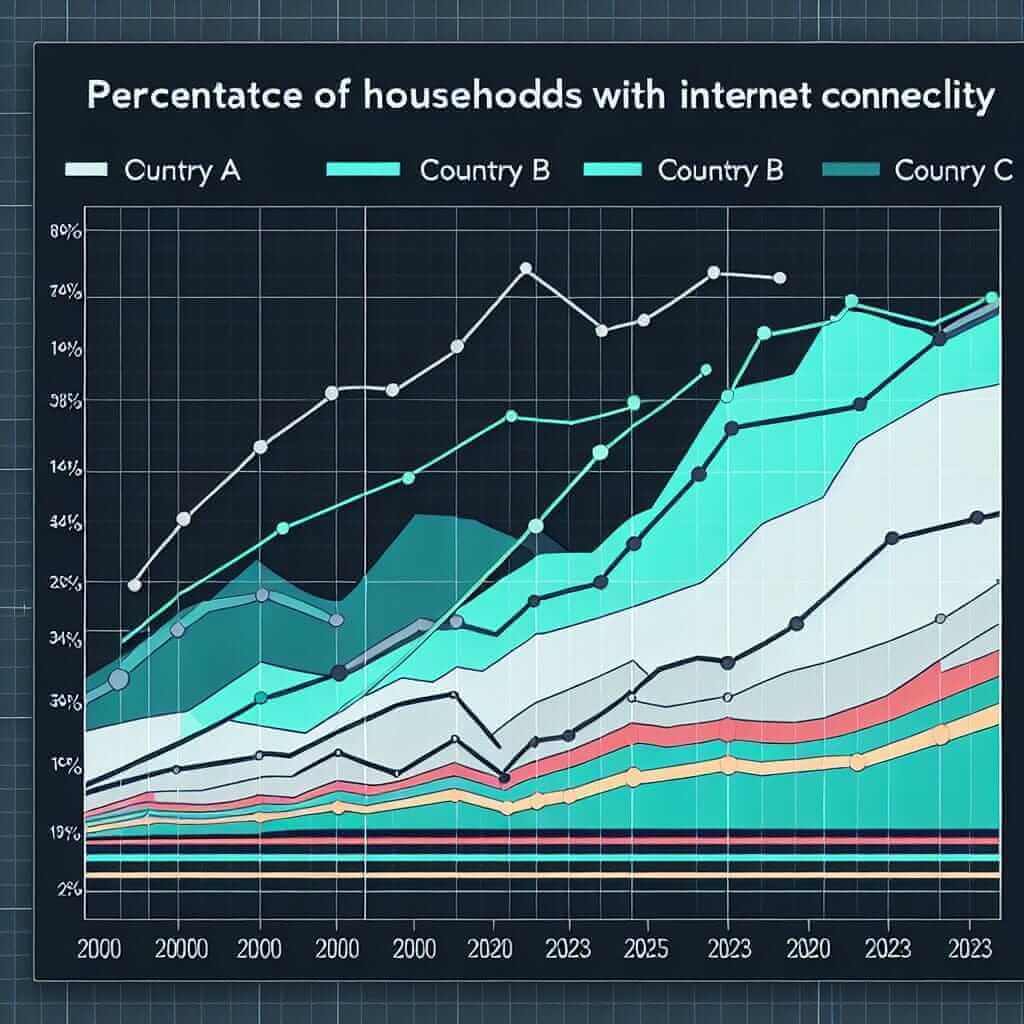Understanding the trends in household internet connectivity from 2000 to 2023 is not only essential for grasping technological advancement but also beneficial for IELTS writing task 1. The internet has revolutionized our lives, and its connectivity trends offer a rich source of data for IELTS test-takers. Task 1 frequently demands candidates to interpret data, and graphs or charts concerning internet connectivity could easily be one of the topics. Let’s explore this topic in detail, with analysis, examples, and strategies to achieve high scores.
Possible IELTS Writing Task 1 Topics
-
Task: Summarise the information by selecting and reporting the main features, and make comparisons where relevant.
- The line graph below shows the percentage of households with internet connectivity in three different countries from 2000 to 2023. Summarise the information.
- The bar chart illustrates the growth in household internet connectivity in urban and rural areas worldwide between 2000 and 2023. Summarise the information.
- The table shows internet connectivity in households among five continents from 2000 to 2023. Summarise the information.
Main Content
Sample Task and Chart
Let’s take the first topic as our focus: the line graph showing the percentage of households with internet connectivity in three different countries from 2000 to 2023.
Sample Line Graph Data:
- Country A:
- 2000: 10%
- 2005: 35%
- 2010: 60%
- 2015: 80%
- 2020: 95%
- 2023: 98%
- Country B:
- 2000: 5%
- 2005: 20%
- 2010: 50%
- 2015: 70%
- 2020: 85%
- 2023: 90%
- Country C:
- 2000: 15%
- 2005: 40%
- 2010: 65%
- 2015: 85%
- 2020: 90%
- 2023: 95%

Analyzing the Task
Analyzing the graph involves:
- Identifying key trends.
- Comparing data between the countries.
- Highlighting significant changes over the years.
Model Answer
The line graph illustrates the percentage of households with internet connectivity in Country A, Country B, and Country C from 2000 to 2023. Overall, it is evident that internet connectivity has increased dramatically in all three countries over the period.
In 2000, Country C had the highest internet connectivity at 15%, followed by Country A at 10%, and Country B at a mere 5%. By 2005, all three countries saw substantial increases, with Country A reaching 35%, Country C at 40%, and Country B at 20%.
The trend continued upward, and by 2010, over half of the households in each country had internet access. Specifically, 60% of households in Country A, 50% in Country B, and 65% in Country C had internet connectivity by 2010.
From 2010 to 2015, the growth rate accelerated, with Country A and Country C achieving 80% and 85%, respectively, while Country B caught up at 70%. The following five years saw each country nearing full saturation. By 2020, the household internet connectivity was nearly uniform across the three countries, with Country A at 95%, Country C at 90%, and Country B at 85%.
In the final observed year, 2023, internet connectivity peaked with Country A leading at 98%, Country C at 95%, and Country B at 90%. The data indicates a steady, robust increase in internet connectivity across all surveyed countries over the 23 years.
(Word count: 224)
Notes on Writing
Vocabulary and Grammar Tips
Using varied and sophisticated vocabulary can boost your band score:
- Percentage: Utilize words like “proportion,” “rate,” or “ratio” for variety.
- Trend Description: Words such as “increase,” “surge,” “climb,” “decline,” “fall,” “dramatically,” “significantly,” “moderately,” and “steadily” are essential.
- Comparisons: Employ phrases like “compared to,” “in contrast,” “while,” “whereas,” and “similarly.”
Grammar Structures
Focus on complex and compound sentences to showcase your grammatical range:
- Time Clauses: “By 2005, the percentage had risen to…”
- Comparative Structures: “Country A grew faster than Country B…”
Essential Vocabulary
- Dramatic (adj) /drəˈmætɪk/: Sudden and remarkable.
- Connectivity (n) /ˌkɒnˈɛktɪvɪti/: The state of being connected.
- Proportion (n) /prəˈpɔːʃən/: A part in relation to the whole.
- Saturation (n) /ˌsætʃʊˈreɪʃən/: The state at which no more can be absorbed.
- Fluctuate (v) /ˈflʌktjʊeɪt/: Rise and fall irregularly.
- Achieve (v) /əˈtʃiːv/: Successfully reach a desired goal.
- Substantial (adj) /səbˈstænʃəl/: Considerable importance and size.
- Accelerate (v) /əkˈsɛləreɪt/: Increase in rate or speed.
- Uniform (adj) /ˈjuːnɪfɔːm/: Not varying; consistent.
- Peak (v/n) /piːk/: Reach the highest point.
Conclusion
For task type involving trends over time, such as internet connectivity, always highlight key trends, compare data across categories, and note significant changes. Using a range of vocabulary and complex grammar structures will enrich your response and aim towards a Band 7 or higher. Practice summarizing various data sources, and you’ll be well on your way to achieving success in the IELTS writing task 1.